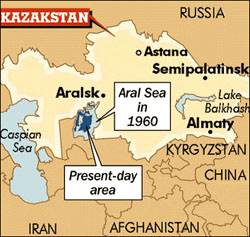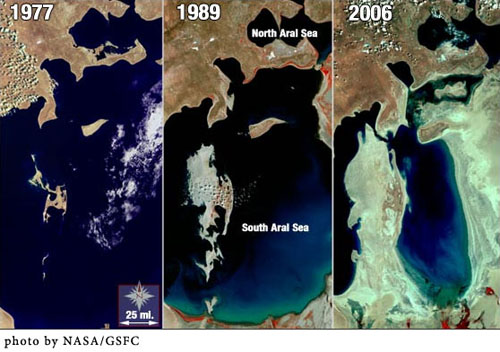Can a concept (World Heritage Status) Save a Sea (the Aral Sea)?
by Mickey Glantz
This article is a condensed version of a longer article that appeared in the June 2007 issue of Ambio, vol. 6, no. 4, titled "Aral Sea Basin: A Sea Dies, a Sea Also Rises" by Michael Glantz
 The Aral Sea is in a vast basin in Central Asia and lies as an island sandwiched between two deserts, the Karakum and the Kyzlkum. It is fed primarily by Central Asia’s two major rivers, the Amudarya and the Syrdarya. During the past 35,000 years, its level has varied widely. The Aral Sea was once the world’s fourth-largest inland sea. Its most recent anthropogenic problems began in the 1960s and 1970s with sharply increased diversion of water from the main rivers that feed the sea. In addition, there is in fact a third manmade 1400km long major river in Central Asia, the Karakum Canal. By 1987, the Aral Sea had lost about 60% of its volume, its depth had dropped by 14 m (45 feet), and its salt concentration had doubled, killing the commercial fishing industry. Wind storms carried toxic dust onto farms a few hundred kilometers downwind, carrying fine grains of pesticide-and herbicide-laden dust that had been deposited for decades on the newly exposed sea floor. Life expectancies in the districts near the sea are significantly lower than in surrounding areas. The sea is now a quarter of the size it was 50 years ago and has broken into several parts, the North Aral Sea and the South Aral Sea (which is nearly separated into two parts). Re-engineering a barrier to separate the Little (North) Aral from the Big Aral has served to retain water in the North Aral Sea.
The Aral Sea is in a vast basin in Central Asia and lies as an island sandwiched between two deserts, the Karakum and the Kyzlkum. It is fed primarily by Central Asia’s two major rivers, the Amudarya and the Syrdarya. During the past 35,000 years, its level has varied widely. The Aral Sea was once the world’s fourth-largest inland sea. Its most recent anthropogenic problems began in the 1960s and 1970s with sharply increased diversion of water from the main rivers that feed the sea. In addition, there is in fact a third manmade 1400km long major river in Central Asia, the Karakum Canal. By 1987, the Aral Sea had lost about 60% of its volume, its depth had dropped by 14 m (45 feet), and its salt concentration had doubled, killing the commercial fishing industry. Wind storms carried toxic dust onto farms a few hundred kilometers downwind, carrying fine grains of pesticide-and herbicide-laden dust that had been deposited for decades on the newly exposed sea floor. Life expectancies in the districts near the sea are significantly lower than in surrounding areas. The sea is now a quarter of the size it was 50 years ago and has broken into several parts, the North Aral Sea and the South Aral Sea (which is nearly separated into two parts). Re-engineering a barrier to separate the Little (North) Aral from the Big Aral has served to retain water in the North Aral Sea.
The region was under the control of the Soviet Union from the mid-1920s until 1991. Climate and soils were excellent for cotton production. Fertilizers, herbicides, and pesticides were applied to the cotton fields in great amounts, based on the assumption that if a little amount did some good, then a lot would do even greater good for cotton production. It was revered as a crop and for its high level of production in the region. Little, if any, political attention was paid, however, to the environmental costs associated with the long-term environmental and societal consequences of cotton production. Quotas set in Moscow drove regional political leaders and collective farm managers to push hard on the workers to meet the unrealistic quotas, quotas that were often met only on paper.

Increasing streamflow diversions during the past five decades have led to a sharp and relatively rapid decline not only in level, but also in societal and ecological well-being. The drying out of the deltas has caused a loss in wetlands, an increase in salinity, a decrease in biodiversity, and an attendant loss in revenue with the destruction of various economic activities dependent on delta habitats for flora and fauna.
Maternal mortality and respiratory and diarrhea diseases are worse there than in the rest of the region. The tuberculosis level is the highest in Europe as well as in the former Soviet Union, and anemia levels are among the highest in the world. Other adverse health effects include hepatitis, malnutrition, high infant mortality, kidney dysfunction, neurological disorder, and cancer.
It is time now to consider partially restoring and maintaining the Big Aral Sea. It would be impossible to refill the Aral to the level of the 1960s without crippling economic development prospects and considerable regional sacrifice. Even if the political and humanitarian will to do so were there, the regional economies are linked so strongly to the production of cotton that water would have to be found elsewhere to ‘‘save the seas.’’ However, it would be possible to refill and stabilize it at an intermediary level by letting predetermined amounts of Amudarya streamflow reach the sea each year for the next several decades. Restoring both seas would help to improve the living conditions in the pre-Aral region and regional human as well as ecological health. In addition, a partially restored Big Aral would serve as an example of how creeping (seemingly insignificant but cumulative) local and regional environmental changes can lead to major national catastrophes in a relatively short period of time.
A partially restored sea could serve both as a symbolic result for present and future generations regarding the lack of understanding of the interactions between humans and nature and as a symbol of human capabilities to restore with time parts of nature that society had destroyed. As an example, arresting the continued decline in sea level in the Big Aral and embarking on a program of partial restoration of the sea could serve to restore faith in learning from experience. Perhaps more to the point is my feeling that if the Big Aral Sea were to disappear, global humanitarian interest in the sea and in the region would dissipate sharply and quickly. In other words, humanitarian aspects for getting involved in efforts to ‘‘save the sea’’ would likely dry up.
The Aral Sea’s impacts on ecosystems and societies have been positive over time. It has produced a rich environment for a range of flora and fauna, terrestrial and aquatic. The region’s two major rivers produced two highly productive inland deltas. The stream ecosystems were also abundant in species of aquatic life at different stretches of the river. The sea in the past had a steady supply of water each spring from the melting glaciers in the nearby mountains.
The positive aspects of the sea for society include the availability of abundant river water for human settlement and economic development purposes and a restoration of biodiversity in the delta as well as the sea. There had been, until recently, a sustainable balance in the Aral Basin’s hydrological cycle; that is, before human intervention disrupted that cycle.
Providing the Aral Sea with World Heritage Status can serve to encourage governments in the region to seek ways to restore the sea to a usable level. Bringing back healthy deltas can restore biodiversity. It can restore a level of fishing and other economic activities and, therefore, livelihoods. It can provide a modicum of hope for the future for inhabitants near the sea, the Karakalpak people, who have been left with little hope and few options short of migrating to other parts of Uzbekistan. There are examples of heritage sites that serve as memorials to sad experiences in human history. The Aral Sea, once the world’s fourth largest inland sea and now not even on the list, deserves Heritage Status as well as restoration. It will take a long time to accomplish this task. Better, then, to get started now.
Mickey Glantz
National Center for Atmospheric Research
glantz@ucar.edu

